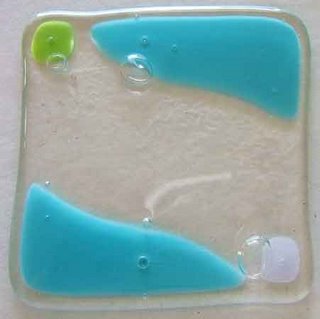Tile Disaster





My big plan was to create a tile that could be slumped into a mold I have. The trouble started with making the initial fused tile. I have HUGE (HUGE!!) bubbles. Probably from making it with the smaller pieces sandwiched between two pieces of clear.
This was a piece that I tried puncturing the bubbles while it was still in the kiln at about 1500 degrees. The bubbles didn't puncture, but my welding gloves smoked!
I decided to experiment with draping anyway. I used a terra cotta saucer (coated with kiln wash) and draped the piece. I thought it draped funny--like it wasn't centered. But by the time it was draped, it was too late.
When I took it from the kiln after cooling, it actually looked pretty cool. Except there was a big crack in one of the corners, right through a bubble. I grabbed a small screwdriver and a hammer, and proceeded to puncture the bubbles, planning on refusing. I figured it would flatten, the bubbles would collapse, and then I could re-drape.
Except while it was just sitting there, it cracked in an entirely different spot. I hear some funny popping sounds, had no idea what they were. Then CRACK!
I'm thinking the piece needs to be put to rest. Maybe I can use pieces for some other project. But I'm thinking its life as a draped or slumped bowl are long gone!


3 Comments:
At Saturday, July 15, 2006 4:37:00 PM, Anonymous said…
Anonymous said…
Your glass is stressed.
If you are sure you used coe compatible glass, then your problem is due to a not long enough anneal time.
The thicker the glass becomes, even if only on the edge...it must be annealed for that thickness.
bubbles...
this issue more times than most is due to the shelf the glass is fusing on
it can also be a spot in the kiln that has a temperature control problem area such as a hot spot
when that happens it causes the glass to uprise with it
this can be addressed by
letting the project rest at 1400 for about 20-30 minutes
to let everything 'catch up'
then proceed to the 1500
or let it stay longer at the 1400-1450 it will fuse at that temp too
just takes a little patience.
At Tuesday, July 18, 2006 2:49:00 PM, Anonymous said…
Anonymous said…
If glass compatibility is not your problem, you might try adding very small chips (1/8") to the corners of your tiles so that the top layer of glass melts down in the center first and the air can escape without getting trapped. I fire to 1425 degrees, turn it off and let sit for 20 minutes before quick cooling to 1000 degrees, then closing it up and letting cool for at least 8 hours.
good luck!
At Monday, February 08, 2010 5:20:00 AM, Juliet said…
Juliet said…
COE compatibility has been covered- the rest can be avoided by kiln timing. To avoid bubbles, try soaking for 10-15 minutes at 1225*F on the way up to your target temp- this allows air bubbles to escape before the two pieces fuse. As far as your crack is concerned: since the breakage is fresh and the edges sharp, it suggests that you're cooling down too quickly. Make sure you anneal soak- around 960*F- for long enough and don't rush the "cool down." Larger and/or thicker pieces need to anneal longer, up to 3 hours depending on the size. Small pendants need only to allow the kiln to cool on its own, anything larger needs 45 minutes to 3 hours depending on the size and thickness.
Petra Kaiser's book, "Fuse It", has a lot of information on kiln firing settings and times.
Good luck!!
Post a Comment
<< Home